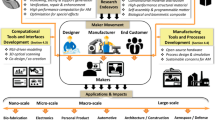Abstract
While interacting feature recognition has received a significant amount of attention, there has been relatively less study of manufacturing planning on interacting feature. At present, most features are machined independently without considering the feature interactions, which more or less induce the reduction of machining efficiency of pockets with interacting features. To address this problem, based on the classification of interacting features, this work proposes an optimal approach to manufacturing planning for aggressive machining of the complex pocket. Firstly, based on the classification of interacting features, the features are grouped and stored in a tree data structure. Secondly, the machining volumes (MVs) are optimized by maximum cutting depth from the root node to the leaf node of the tree model. Finally, the MVs that are composed of complex machining faces are split into several machining cells (MCs), and genetic algorithm (GA) is employed to get optimal MVs. To demonstrate the advantages of the innovative approach, two case studies are rendered, and the results are compared to those obtained by the traditional methods. The proposed approach can be directly implemented into current CAD/CAM software to promote aggressive rough and finish machining of complex pockets in industry.
Similar content being viewed by others
References
Verma AK, Rajotia S (2010) A review of machining feature recognition methodologies. Comput Integr Manuf Syst 23(4):353–368
Corney J, Hayes C, Sundararajan V, Wright P (2005) The CAD/CAM interface: a 25-year retrospective. J Comput Inf Sci Eng 5(3):188–197
Wang W, Li Y, Ma Y (2013) Towards a feature-based agent-driven NC tool path generation to support design and process changes. Comput Aided Des Appl 10(4):603–618
Garcia F, Lanz M, Järvenpää E, Tuokko R (2011) Process planning based on feature recognition method. IEEE International Symposium on Assembly and Manufacturing, pp 1–5.
Wang W, Li Y, Huang L (2016) Rule and branch-and-bound algorithm based sequencing of machining features for process planning of complex parts. J Intell Manuf 2016:1–8
Huang R, Zhang S, Bai X, Xu C (2014) Multi-level structuralized model-based definition model based on machining features for manufacturing reuse of mechanical parts. Int J Adv Manuf Technol 75(5):1035–1048
Zhang X, Nassehi A, Newman ST (2014) Feature recognition from CNC part programs for milling operations. Int J Adv Manuf Technol 70(1):1–16
Marchetta MG, Forradellas RQ (2010) An artificial intelligence planning approach to manufacturing feature recognition. Comput Aid Des 42(3):248–256
Sunil VB, Agarwal R, Pande SS (2010) An approach to recognize interacting features from B-Rep CAD models of prismatic machined parts using a hybrid (graph and rule based) technique. Comput Ind 61(7):686–701
Chu XN, Tang CS, Xue DY, Su YL, Sun XW (2012) Identification of machining features based on available resources of cutting tools. Int J Prod Res 50(15):4141–4157
Yu FF, Du BR, Ren WJ, Zheng GL, Chu HZ (2008) Slicing recognition of aircraft integral panel generalized pocket. Chin J Aeronaut 21(6):585–592
Liu Z, Wang L (2007) Sequencing of interacting prismatic machining features for process planning. Comput Ind 58(4):295–303
Xu JL, Zheng GL, Du BR, Chu HZ, Wu FM (2014) Mathematical model and algorithm of toolpath optimisation on aircraft structural parts. Int J Prod Res 52(4):1142–1149
Hua GR, Zhou XH, Ruan XY (2007) GA-based synthesis approach for machining scheme selection and operation sequencing optimization for prismatic parts. Int J Adv Manuf Technol 33(5):594–603
Chen ZC, Fu Q (2011) An optimal approach to multiple tool selection and their numerical control path generation for aggressive rough machining of pockets with free-form boundaries. Comput Aided Des 43(6):651–663
Kiswanto G, Lauwers B, Kruth JP (2007) Gouging elimination through tool lifting in tool path generation for five-axis milling based on faceted models. Int J Adv Manuf Technol 32(3):293–309
Merdol SD, Altintas Y (2008) Virtual cutting and optimization of three-axis milling processes. Int J Adv Manuf Technol 48(10):1063–1071
Bouard M, Pateloup V, Armand P (2011) Pocketing toolpath computation using an optimization method. Comput Aid Des 43(9):1099–1109
Heo EY, Kim DW, Lee JY, Lee CS, Chen FF (2011) High speed pocket milling planning by feature-based machining area partitioning. Robot Comput Integr Manuf 27(4):706–713
Kim HC (2010) Tool path generation for contour parallel milling with incomplete mesh model. Int J Adv Manuf Technol 48(5):443–454
Held M, Spielberger C (2009) A smooth spiral tool path for high speed machining of 2D pockets. Comput Aid Des 41(7):539–550
Saffar R J, Razfar M R, Salimi A H, et al. (2009) Optimization of machining parameters to minimize tool deflection in the end milling operation using Genetic Algorithm. World Appl Sci J 64–69
Li Y, Liu X, Gao JX, Maropoulos PG (2012) A dynamic feature information model for integrated manufacturing planning and optimization. CIRP Ann Manuf Technol 61(1):167–170
Chen SL, Zheng GL, Zhou M, Du BR, Chu HZ (2013) Processscheme-driven automatic construction of NC machining cell for aircraft structural parts. Chin J Aeronaut 26:1324–1335
Pal P, Tigga AM, Kumar A (2005) A strategy for machining interacting features using spatial reasoning. Int J Mach Tools Manuf 45(3):269–278
Zheng ZJ, Zheng GL, Zhou M, Chen SL (2017) An algorithm for precise machining area computation in rough machining of complex 3D pocket. Int J Adv Manuf Technol 2017:1–10
Author information
Authors and Affiliations
Corresponding author
Rights and permissions
About this article
Cite this article
Zheng, Z., Wang, Q., Zheng, G. et al. An optimal approach to manufacturing planning for complex prismatic parts with interacting feature. Int J Adv Manuf Technol 94, 585–597 (2018). https://doi.org/10.1007/s00170-017-0865-1
Received:
Accepted:
Published:
Issue Date:
DOI: https://doi.org/10.1007/s00170-017-0865-1




